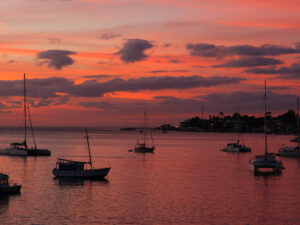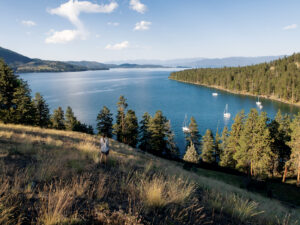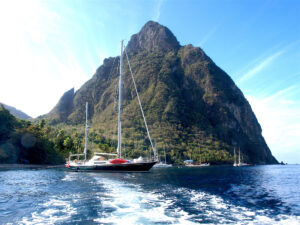We’re anchored tonight in a lagoon about half a mile south of the small Kuna village of Caledonia, and 50 yards west of the uninhabited island of Suletupu, where Kuna men and women paddle every day in their wooden ulus to harvest coconuts and breadfruit, to fish, to collect large stones for their land-reclamation projects, and to sell us molas. Tucked within a circle of mangroves, reefs, and islets of coconut trees, Ithaka rests in a clear pool, fully surrounded by beauty and barriers. The steady trade winds keep us cool below decks but fail even to ruffle the water surface. This is one of the prettiest settings we’ve known.
| | Sunset is generally a pretty good reminder to just plain stop whatever youre doing and sit there.* * *|
Our anchorage, in the easternmost section of Kuna Yala, and off the usual San Blas cruising path, makes Gringo and Indian mutually pleasant novelties for each other. When the Kunas come by, their ulus sometimes low in the water with whole families, they approach wide-eyed and hang onto our fenders, peering into the ports and cockpit. With elastic schedules, their visits are rarely just for a minute or two. Sometimes, depending on what we’re doing or who stops by or how captivating their molas are, the get-together might end with the family coming aboard for lemonade.
| | Photo courtesy of Roy Mallen on s/v Lisa| | The Kuna women are usually our first connection to the communities we visit. Sometimes, even before the anchor is down, they’ve paddled their ulus out to sell molas. * * *| Or, if the mood’s right, when it’s late in the day, it’s rum instead, and we watch the sunset together. No one needs language for that. But even with our linguistic limitations, the experience of being here together transcends any immediate need for tenses and grammar. On various evenings Kuna guests have told us about political factions in their communities, about their schools, clinics, work, and hopes. They’ve explained some of their traditions—many of which are depicted in the women’s extraordinary _molas_. They’ve taught us about different Kuna family dynasties, and how a _saila_ (village chief) wields and maintains power. Over and over we’ve heard about their babies who’ve died; every family seems to have lost a couple of newborns. Any complication at birth presents a lethal danger here.
Weve told people about our families, and shown them a small picture album of everyone back homealways a source of fascination, bewilderment, and excitement. They ask everyones ages, how many children we have and, when we say none, they gape for a speechless moment as if we were space alienswhich in ways we are. Once, a 22-year-old mother with six kids and a new babe at her breast, when she heard we didnt have children, looked sad, thought hard, and shyly offered us her infant. In some touching ways, she meant it. The temptation was enormous.
|
| | Weve taken to making our own bread and yogurt. Our Interlux insulated bag is a perfect overnight yogurt incubator. * * *|
These are not easy conversationsthe Kuna language is wildly difficult to decipher, and for most adult Kuna, Spanish is a distant second tongue. But its always rewarding to try, especially with the help of the brighter kids, who, in addition to Spanish and Kuna, in their one-room, thatched-hut school also study a smattering of English. With or without their help, technical precision is a frequent casualty, but emotional nuances prevail. Take enough time, listen closely, draw a few pictures, point wildly, dramatize vigorously, and keep to human topics. It always seems to work.
When an ulu visits full of children and moms, we package up a zip lock of dry whole milk, and we bring out the bubble wands. Soon the anchorage echoes with squeals as the kids jump around in their ulus or on Ithaka, trying to capture the floating bubbles. They instinctively understand what most adults seem to forget over time: a bubble’s life is brief; there are never enough of them, and you need to catch them when you can.
| | Photo courtesy of Roy Mallen on s/v Lisa| | At every island in the San Blas we’ve added molas to a collection so large that Ithaka now rides lower in the water. They’re magnificent, and most cruisers can’t resist leaving with a stack of them. * * *| Tonight, we talked together of moving on, and realized with a start that, right now, _Ithaka_ is at the southernmost point we’re likely to touch on our cruise of the western Caribbean. After this, we begin making northward progress, eventually, toward home—a stunning prospect. Even if we take as long to get back up there as we took to arrive down here, merely turning north feels huge.
We chat and brainstorm and plan, as we always do, musing about where we’re headed—both immediately and in the grander scheme—trying to figure out how best to balance passion for the traveling life, and our happiness living on Ithaka, with creative ways to earn a living and spend time with our families at home. This is the quintessential cruisers’ dilemma: how to successfully integrate disparate parts of our lives, without reducing cruising to an all-or-nothing proposition.
One way or another, Suletupu is a turning point for us, as its here, too, after almost three years of connecting with you, that with this installment the online Log of Ithaka comes to an end.
| | Ithaka on the hook* * *| As with all the exciting parts of this cruising life, we had no idea when we took it on how much the internet Log would demand from us, nor how great would be the pleasure of its rewards. It’s been a way for us to keep track of our experiences, and at the same time it’s been a forgiving, demanding, or humorous conscience. On occasions of startling success, it’s been our songfest; on darker days, a confessional dirge.
Paul Theroux, an author who knows a little about this, wrote that “being mistaken is the essence of the travelers tale.” Hes right, and weve chronicled a lot of our not-knowing, letting the surprises become something bigger and richer than we ever could have imagined. Our Log has helped us make sense out of things that jarred our expectationswhy travel at all if you know in advance what youll find?
Some weeks we’ve used the Log as conversation between you and us, and also between ourselves. Occasionally, the Log has been like a third person on Ithaka—adored when there’s a good story to share, but merely tolerated when we’re on deadline and sick to death of ourselves. (Oh, some of the arguments when we’re editing each other!) But mostly this internet Log has been a much-treasured way for us to play creatively, to understand and keep track of how we felt when experiences are new, when we pushed beyond our usual limits. Mostly, we’ve tried to capture a few of life’s bubbles before knowledge or new experience claimed them.
|
| | In Kuna Yala, we spend most days in bathing suits, always ready to resume the underwater hunt for the perfect dinner. * * *|
There really are no perfect points at which to end this sort of public journal, but here—at 8 degrees, 53.77 minutes above the equator—as we turn Ithaka northward, it seems like a reasonable moment. We look forward this year to living as fully as possible, and spending fewer hours in front of the computer. We’re grateful that we’ll continue to have the opportunity to write the Log of Ithaka for the monthly back page of Cruising World, as well as features for the magazine, and in so doing remain connected with you. We continue to welcome your humor, questions, and musings at Ithaka@cruisingworld.com. Your e-mails have breathed life into our work and into our cruise.
| | The tempting water around Ithaka* * *| The gold of cruising is linking with people you’d not have known otherwise—both fellow cruisers and locals—but one pays for the inevitably frequent and painful partings. We’ve learned not to say goodbye, because that word imposes a harsh finality. We’ve come to prefer more encouraging and mystical phrases that embody both the hope of a future, and the spiritual aspect of friendship and separation: See you later. _¡Hasta luego!_ _Ciao! ¡Vaya con Dios! ¡Adios, amigos!_ And, in Kuna, “_Panemalo!”_
We have one more project to finish before we leave herethe installation of our brand-new Pactor modem, which connects to the computer and single-sideband radio, and with the Sailmail software program will give us back our onboard e-mail capability. Getting the modem here in Suletupu has been a relay adventure involving a fusion of First- and Third-World logistics, good fortune, and typical cruiser cooperation.
| | Photo courtesy of Roy Mallen on s/v Lisa| | Every afternoon on Isla Pinos, up island a bit from Ithaka‘s nest in Suletupu, the women practiced traditional dances in preparation for an inter-island competition in two weeks time. * * *| Last week, we purchased the modem over our SSB from Pactor’s local representative, Michael on _Iron Lady_, who had it air expressed from the factory to Germany to Panama City. Before he and Natalie set sail for the Galapagos, they stowed it at the Balboa Yacht Club with _Le Petit Prince_, who handed it off to our pal Gringo Joe Logan, an American expat who’s the best friend any cruiser could have in Panama, or anywhere else for that matter. He drove it to the national airport and put it on a puddle-jumper bound for the remote islands, and this morning at 6 a.m. we dinghied the five miles to pick it up at the airstrip in Mulutupu. Shipping cost from Panama City: 50 cents. Then, with counsel from Jim on _Asylum_, Frank on _Simba_, Dennis on _WC Fields_, and Gringo Joe, we started splicing wires, and hooking things up, and this afternoon we sent and received for the first time. This never would have happened without a whole lot of help. Tomorrow, if the winds cooperate, after we tuck in the wires, it’s time to move on.
When we do, Ithaka will putter between the two reefs that make our safe nest here, trace the white-powder beaches of Suletupu, then pass the happy commotion of Caledonia. Beyond its lee we expect to be hit by the enormous swells we rode in here, swells that almost put Ithaka‘s spreaders in the drink a few times. Then we’ll begin the roller-coaster ride to Mamitupu, another tiny village famous for its traditional ways and, of course, its molas.
| | Photo courtesy of Roy Mallen on s/v Lisa| | A typical home in Kuna Yala usually contains at least two generations, with everyone sleeping in hammocks. * * *|
When we’re abeam of Caledonia, though, we hope the children run along the waterfront and wave, as they did when we sailed in more than a week ago. Now, we know many of them, have broken bread with some of their parents, and we carry aboard Ithaka a collection of their mothers’ handiwork, and our newest memories. Through all these encounters, another small corner of the world has come to life, and for us, that’s the best part of cruising.
| THANK YOU |
| | Lisa Harris, known as one of Kuna Yalas master mola makers, is famous for her work, for being a transvestite, and for establishing a museum for outstanding molas* * *| The internet Log Of Ithaka has enjoyed the help and backing of some very cool people. Sally Helme put her support and that of _Cruising World_ behind us, always encouraging us to tell it like it is. Herb McCormick, Tim Murphy, and Elaine Lembo have been great sounding boardsespecially Tim, our Logs thoughtful editor. Jason White gave us invaluable technical advice.
The Log wouldn’t have looked so beautiful were it not for the dedication of CW‘s webmaster, our main man and yours on this site, Jeff Roy. His friendship has added great pleasure to our cruise. Originally, this Log was the brainchild of Jock West, who wanted to bring to life on the internet every week the ups and downs of a real cruise, and invited us to write it.
| | Bernadette and Douglas* * *| Finally, this log might have become one more Then-I-Did-This-And-Then-I-Did-That recitation were it not for the thousands of readers whove sent us their own stories, wise and pithy comments, and kept us a little closer to the bone. To everyone above, and to all of you whove joined us on the journey, our deepest thanks.
e-mail the Bernons: Ithaka@CruisingWorld.com








